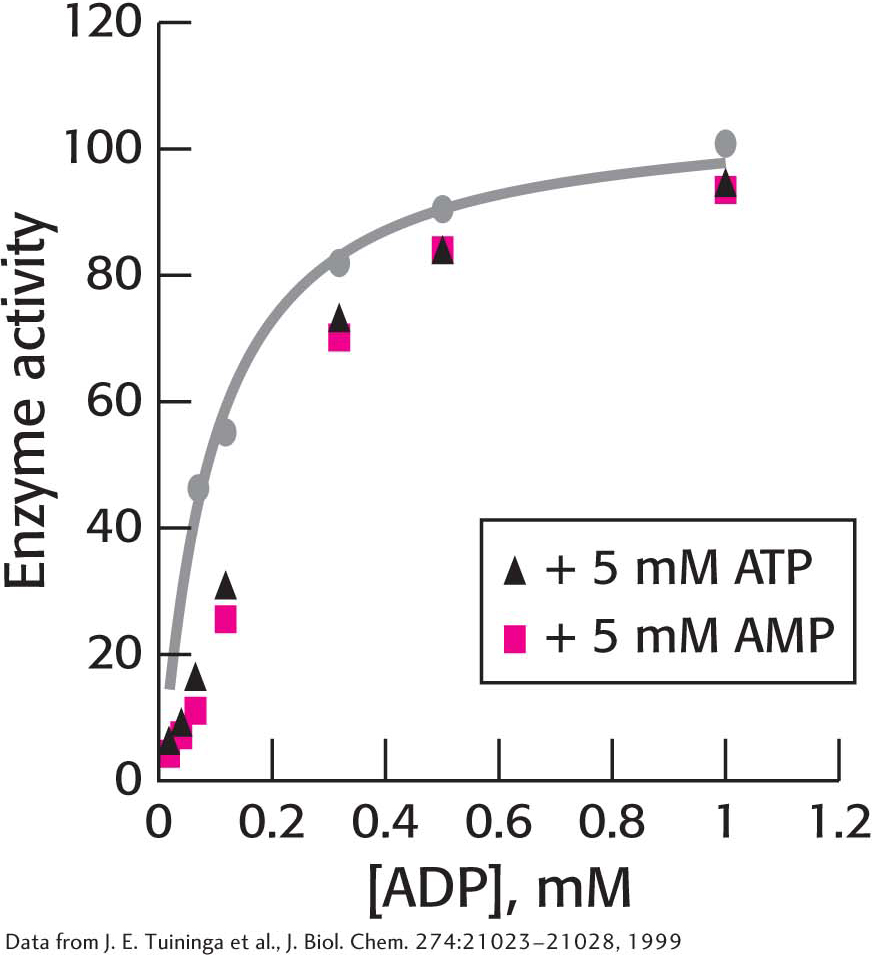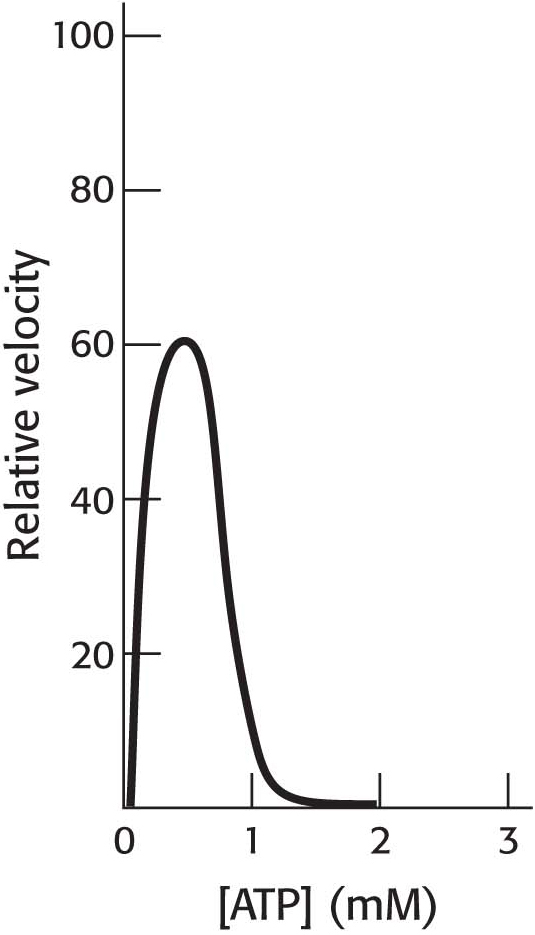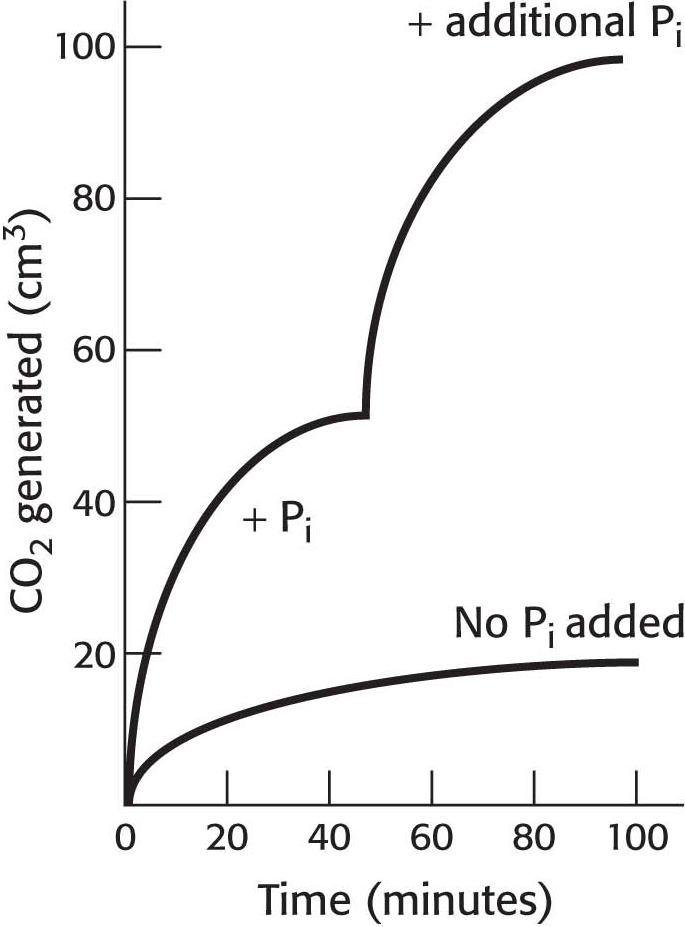PROBLEMS
Question 16.1
1. Just right. Suggest some possible reasons why glucose is fuel used by all organisms.
Question 16.2
2. Like the owl and the pussycat. Match each term with its description.
Hexokinase Phosphoglucose isomerase Phosphofructokinase Aldolase Triose phosphate isomerase Glyceraldehyde 3- Phosphoglycerate kinase Phosphoglycerate mutase Enolase Pyruvate kinase | Phosphorylates glucose Converts 3- Forms fructose 1,6- Generates the first high- Generates the second high- Converts glucose 6- Generates the first molecule of ATP Cleaves fructose 1,6- Catalyzes the interconversion of three- Generates the second molecule of ATP |
Question 16.3
3. Who takes? Who gives? Lactic acid fermentation and alcoholic fermentation are oxidation–
Question 16.4
4. ATP yield. Each of the following molecules is processed by glycolysis to lactate. How much ATP is generated from each molecule?
(a) Glucose 6-
(b) Dihydroxyacetone phosphate
(c) Glyceraldehyde 3-
(d) Fructose
(e) Sucrose
Question 16.5
5. Enzyme redundancy? Why is it advantageous for the liver to have both hexokinase and glucokinase to phosphorylate glucose?
Question 16.6
6. Enzyme properties. In the liver and the pancreas, hexokinase and glucokinase phosphorylate glucose. Glucokinase is active only when the blood concentration of glucose is high. How might glucokinase differ kinetically from hexokinase so as to function only at high glucose levels?
Question 16.7
7. Required isomerization. Why is the isomerization of glucose 6-
Question 16.8
8. Magic? The interconverison of DHAP and GAP greatly favors the formation of DHAP at equilibrium. Yet the conversion of DHAP by triose phosphate isomerase proceeds readily. Why? ✓ 1
Question 16.9
9. Between two extremes. What is the role of a thioester in the formation of ATP in glycolysis?
Question 16.10
10. Corporate sponsors. Some of the early research on glycolysis was supported by the brewing industry. Why would the brewing industry be interested in glycolysis? ✓ 2
Question 16.11
11. Recommended daily allowance. The recommended daily allowance for the vitamin niacin is 15 mg per day. How would glycolysis be affected by niacin deficiency? ✓ 2
Question 16.12
12. Who’s on first? Although both hexokinase and phosphofructokinase catalyze irreversible steps in glycolysis and the hexokinase-
Question 16.13
13. The tortoise and the hare. Why is the regulation of phosphofructokinase by energy charge not as important in the liver as it is in muscle? ✓ 1
Question 16.14
14. Running in reverse. Why can’t the reactions of the glycolytic pathway simply be run in reverse to synthesize glucose?
Question 16.15
15. Destiny. What are the principle fates of pyruvate generated in glycolysis?
Question 16.16
16. Road blocks. What reactions of glycolysis are irreversible under intracellular conditions?
Question 16.17
17. No pickling. Why is it in the muscle’s best interest to export lactic acid into the blood during intense exercise?
Question 16.18
18. Proper preparation. Describe the pathways by which fructose is prepared for entry into glycolysis.
Question 16.19
19. Trouble ahead. Suppose that an obligate anaerobe suffered a mutation that resulted in the loss of triose phosphate isomerase activity. How would this loss affect the ATP yield of fermentation? Could such an organism survive?
Question 16.20
20. High potential. What is the equilibrium ratio of phosphoenolpyruvate to pyruvate under standard conditions when [ATP]/[ADP] = 10?
Question 16.21
21. Hexose-
Question 16.22
22. Distinctive sugars. The intravenous infusion of fructose into healthy volunteers leads to a two-
(a) Why is glycolysis more rapid after the infusion of fructose?
(b) Fructose has been used in place of glucose for intravenous feeding. Why is this use of fructose unwise?
Question 16.23
23. Arsenate poisoning. Arsenate (AsO43−) closely resembles Pi in structure and reactivity. In the reaction catalyzed by glyceraldehyde 3-
Question 16.24
24. Reduce, reuse, recycle. In the conversion of glucose into two molecules of lactate, the NADH generated earlier in the pathway is oxidized to NAD+. Why is it not to the cell’s advantage to simply make more NAD+ so that the regeneration would not be necessary? After all, the cell would save much energy because it would no longer need to synthesize lactic acid dehydrogenase. ✓ 2
Question 16.25
25. Diverted resources. Phosphofructokinase converts fructose 6-
Question 16.26
26. Like Batman and Robin. Match parts a through j with parts 1 through 10.
Glucose 6- LowATP/AMP ratio Citrate Low pH Fructose 1,6- Fructose 2,6- Insulin Has a high KM for glucose Transporter specific to liver and pancreas HighATP/AMP ratio | GLUT2 Stimulates phosphofructokinase Inhibits phosphofructokinase in muscle Inhibits phosphofructokinase Stimulates phosphofructokinase in the liver Glucokinase Inhibits phosphofructokinase in the liver Causes the insertion of GLUT4 into cell membranes Inhibits hexokinase Stimulates pyruvate kinase |
Chapter Integration Problems
Question 16.27
27. State function. Fructose 2,6-
Question 16.28
28. Not just for energy. People with galactosemia display central nervous system abnormalities even if galactose is eliminated from the diet. The precise reason for this is not known. Suggest a plausible explanation.
Question 16.29
29. Not MTV. A ligand-
Question 16.30
30. Power to the rbc! Hexokinase in red blood cells has a KM of approximately 50 μM. Because life is hard enough as it is, let’s assume that the hexokinase displays Michaelis–
Data Interpretation and Challenge Problems
Question 16.31
31. Now that’s unusual. Phosphofructokinase has been isolated from the hyperthermophilic archaeon Pyrococcus furiosus. The kinase was subjected to standard biochemical analysis to determine basic catalytic parameters. The processes under study were of the form
The assay measured the increase in fructose 1,6-
(a) How does the P. furiosus phosphofructokinase differ from the phosphofructokinase considered in this chapter?
(b) What effects do AMP and ATP have on the reaction with ADP?
Question 16.32
32. Confused? The adjoining graph shows muscle phosphofructokinase activity as a function of ATP concentration in the presence of a constant concentration of fructose 6-
Question 16.33
33. Brewing. The adjoining graph shows results of experiments on the alcoholic fermentation of glucose with the use of yeast extracts. The graph shows the volume of carbon dioxide released (y axis) as a function of time (x axis). ✓ 2
(a) Is measuring the rate of carbon dioxide release a reliable means to measure alcoholic fermentation? Explain.
(b) Why is glucose fermentation dependent on phosphate?
(c) Why is more carbon dioxide generated if the extract is supplemented with phosphate?
(d) During the fermentation, what would the ratio of carbon dioxide generated to phosphate consumed be expected to be?
(e) When fermentation slowed, a hexose bisphosphate accumulated. What is this compound, and why would it accumulate?
Challenge Problems
Question 16.34
34. Kitchen chemistry. Sucrose is commonly used to preserve fruits. Why is glucose not suitable for preserving foods? ✓ 1
Question 16.35
35. Tracing carbon atoms. Glucose labeled with 14C at C-
(a) What is the location of 14C in the pyruvate that is formed? (Assume that the interconversion of glyceraldehyde 3-
(b) If the specific activity of the glucose substrate is 10 mCi mmol−1, what is the specific activity of the pyruvate that is formed?
Question 16.36
36. Lactic acid fermentation. ✓ 2
(a) Write a balanced equation for the conversion of glucose into lactate.
(b) Calculate the standard free-
(c) What is the free-
Question 16.37
37. Après vous. Why is it physiologically advantageous for the pancreas to use GLUT2, with a high KM value, as the transporter that allows glucose entry into ß cells?
Question 16.38
38. Bypass. In the liver, fructose can be converted into glyceraldehyde 3-
Question 16.39
39. An informative analog. Xylose has the same structure as that of glucose except that xylose has a hydrogen atom at C-
Question 16.40
40. Quick-
The equilibrium constant for this reaction is close to 1, inasmuch as the number of phosphoanhydride bonds is the same on each side of the equation. Use the equation for the equilibrium constant for this reaction to show why changes in [AMP] are a more effective indicator of the adenylate pool than those in [ATP]. ✓ 1
Selected Readings for this chapter can be found online at www.whfreeman.com/